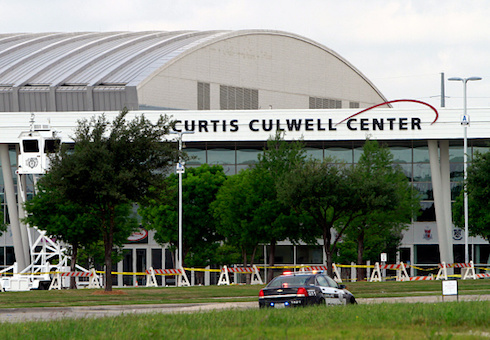A federal judge has dismissed a lawsuit by a security guard who was injured during a 2015 terror attack by ISIS radicals in Garland, Texas. Bruce Joiner alleged the FBI was liable, arguing the bureau had prior knowledge of the impending violence and had even helped incubate the idea with attackers, but then failed to stop it.
Joiner was shot in the lower leg after Elton Simpson and Nadir Soofi opened fire at a perimeter checkpoint at the Curtis Culwell Center in Garland, where inside "The First Annual Muhammad Art Exhibit and Contest" was taking place.
ISIS later claimed responsibility, marking the first time the terror group ever carried out an attack on U.S. soil. Simpson and Soofi were fatally shot within yards of where their attack began.
Documents released through other court cases, however, revealed how close the FBI was to the action of the attack, which has since drawn media and congressional scrutiny.
Shortly after the "Muhammad Art Exhibit" event was announced in early 2015, the undercover agent who had been infiltrating the small cell of radicals texted Simpson, saying, "tear up Texas."
Additionally, the undercover agent was in a separate car directly behind Simpson and Soofi when they opened fire and had been taking pictures of the attackers' car just seconds before the shooting began.
When the first shots were fired, the undercover agent fled his own vehicle, but was apprehended by local police, at which point the agent told police he was undercover with the FBI.
Joiner claimed the FBI was liable for his injury and was seeking millions in damages but has consistently maintained that his lawsuit was about getting information from the bureau to uncover the full extent of their actions leading up to the attack.
"It seems like it had to have been one or the other," Joiner's attorney Trenton Roberts said in 2017, just a few months before filing the lawsuit. "Just a complete botched operation where [the FBI] don't want the attack to actually take place, or, it's something where they need the attack to take place in order for [the agent] to advance in the world of ISIS."
Joiner and Roberts went further in their court filing, alleging a cover up at the highest levels of the FBI.
"In the aftermath of the attack, former FBI Director James Comey lied to the American people by claiming that Simpson was a 'needle in a haystack' that was 'invisible to us,'" the filing said. "Even after it had come to light that an undercover FBI agent had been communicating extensively with the terrorists during the week prior to the event and had accompanied them as they carried out the attack, the FBI continued to assert that 'there was no advance knowledge of a plot to attack the cartoon drawing contest.'"
Roberts did not respond to requests for comment for this article, including questions as to whether any kind of appeal might be pursued.
The Department of Justice and the FBI were invoking government immunity for their defense.
Judge Karen Gren Scholer in the Northern division of U.S. District Court delivered her ruling on the Friday before Christmas.
"The Court finds that the conduct alleged by Plaintiff fall within the scope of the discretionary authority conferred on the FBI by the Undercover Guidelines and the DOIG [Domestic Investigations and Operations Guide]."
As the case progressed in 2017, the DOJ lawyers representing the FBI had asked the judge to delay discovery in the case until a ruling on dismissal had been provided. Therefore, another consequence of Scholer's ruling is that Joiner did not receive any additional documentation from the bureau about their activities leading up to the attack, and the odds of ever obtaining any additional information from the FBI now seem slim or nonexistent.
In another court filing related to Joiner's suit, the DOJ had described the "tear up Texas" text message as "innocuous."
In March of last year, the undercover agent testified against the ringleader of the entire attack, Erick Jamal Hendricks. The testimony came under highly unusual circumstances where the agent appeared on the stand under a light disguise and using a pseudonym, and the courtroom was cleared except for attorneys, jury members, and essential court members.
In that testimony, the agent said he did not have advance knowledge of the attack, and was surprised when the shooting began.
Other documents about the attack reside with the Garland Police Department, but open records loopholes in Texas have allowed the department to avoid disclosing them.
Also, in a press conference just days after the attack, the Garland police chief answered questions at length about the attack and the response. The chief did not make any mention of apprehending and detaining an undercover FBI agent on the scene, a fact that had not yet been put in the public sphere through court cases.
The entire affair minus Joiner's lawsuit became the subject of a 60 Minutes expose. On Capitol Hill, Republican senators Ron Johnson (Wis.,) and Ted Cruz (Tex.) pushed FBI officials for more accountability on the bureau's actions, including questioning FBI director James Comey on the issue in open testimony prior to Comey's firing by President Trump.
But little else about the attack has been produced with the exception of the testimony of the undercover agent during the prosecution of Hendricks, who was found guilty of "attempting and conspiring to provide material support" to ISIS.
